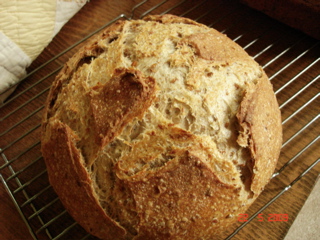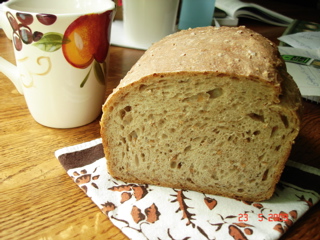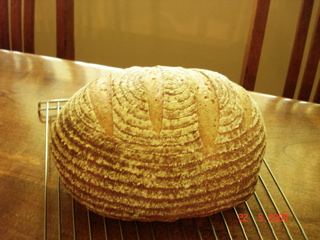I went to a local grist mill, called Fall's Mill in TN, and found some fresh cracked wheat. This is the bread recipe on the side of the bag:
In a large mixing bowl pour 1 1/2 cups of boiling water over:
2 cups cracked wheat
1 stick butter
1/2 cup brown sugar
1 tablespoon salt
1 cup wheat germ
Let cool. Meanwhile dissolve 1 package yeast in 1/2 cup warm water with 1 tablespoon sugar. Set aside to cool.
Add 1 egg and 1 1/2 cups warm water to cooled wheat mixture. Add yeast and beat in 4 cups of bread flour. Work in additional 4 cups of bread flour by hand to make a fairly firm dough. Knead 5-10 minutes and turn into a greased bowl. Let rise for 1 1/2 hours in a warm place. Punch down and divide into thirds. Form 3 loaves and let rise an additional 1-1 1/2 hours. Bake at 350F for 30 minutes or more. Check often for even browning. Pull out pan, put back in oven for 1-2 minutes to crisp the crust.
Now, my changes to the above were (don't we all tweak a bit?) -- I only made half the recipe as 3 loaves is way too much for just me and hubbie. I used half bread and half AP flours. I made a poolish with 6 ounces warm water + 6 ounces flour + 1/8 tsp of ADY and let it sit at room temp for 3 hours. I only kneaded 5 minutes by machine and 5 by hand. The final dough was shaped into one large loaf (9x5 pan) and a smaller (7x3x2). Total baking time was 45 min. and 25 minutes respectively.
 cracked wheat
cracked wheat 
The taste was very nice with the cracked wheat kernels soft and detectable. Next time I think I would put in a portion of whole wheat flour.
Now I was so enamored with the cracked wheat that when I found a recipe in "Breadtime" by S.J. Cheney with sourdough I thought I'd try that too. The recipe is similar to the above, called Yeasted Sourdough Cracked Wheat Bread and the ingredients are:
3 cups spring water
1 cup cracked wheat or rye
1 cup sourdough starter
7 1/2 cups whole wheat bread flour
1/4 tsp active dry yeast
2 teaspoons sea salt
2 tablespoons corn or other vegetable oil
This time I made the whole amount, a lot of dough it is! I had been grooming my whole wheat starter a couple days before so that was used and I did soak the cracked wheat overnight with a pinch of salt. I didn't want a totally wheat bread so I used 1/3 whole wheat flour and the rest AP. I shaped the final amounts into one large boule which I baked in a preheated covered cast iron pot and the remaining into a 9x5 loaf (which turned out to be too big - next time I'll use an 8x4). Baked at 400F for 20 minutes, then uncovered with heat decreased to 350F for 28 more minutes. They both were removed from pans and set in oven with door slightly cracked for an additional 5 minutes to crisp the crust.


This taste of cracked wheat with the sourdough was more tasty with a light sourdough flavor, but the cracked wheat was less pronounced. I think I should have not soaked it so long. But, I liked this as well if not better than the non-sourdough one.
I'm so pleased with my whole wheat sourdough starter. I know more and more every week how it reacts to temperature and technique, when it is ready and at it's best. It's nicely active -- which means every week I feed it, and each time I want to bake bread I "groom" it by refreshing/feeding it for 2 or 3 times every 12 hours beforehand. I do use the ratio of 1 part starter/3 parts water/4 parts wheat flour. Works for me.
I also used my starter for Hamelman's Light Rye bread. It turned out so nice. I do think it is because of my sourdough starter and some newly bought whole rye flour from KA. But Hamelman's recipes always seem to work for me, too.
 Hamelman's light rye
Hamelman's light rye
So, my freezer is full of saved bread and I'm still eager to try some more recipes before the heat of summer makes me wish I had a southern outdoor kitchen out back.
Anet